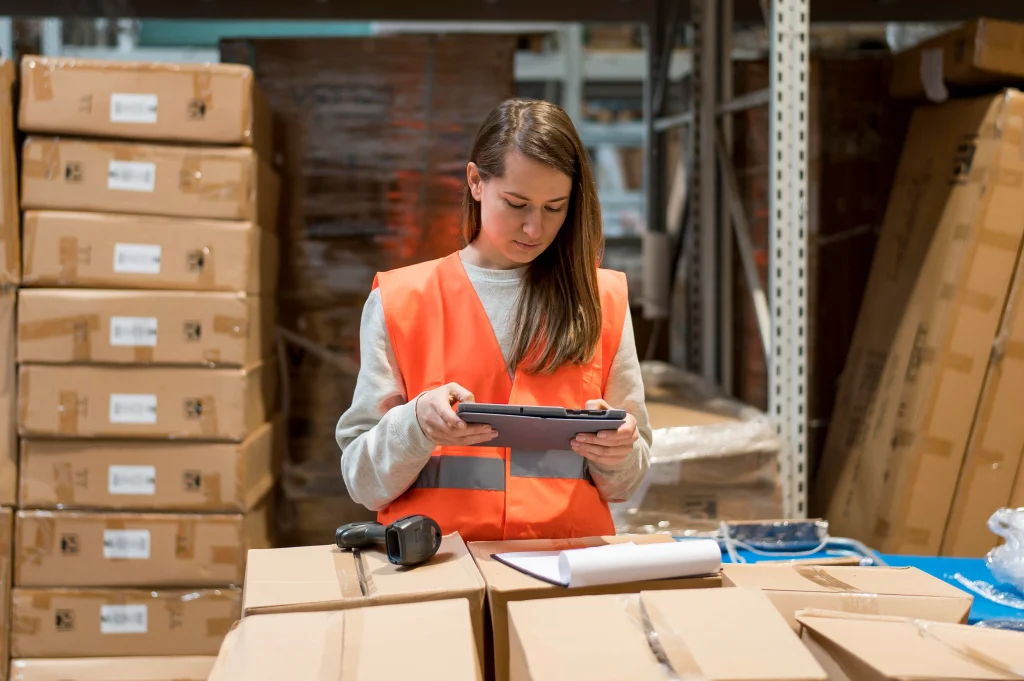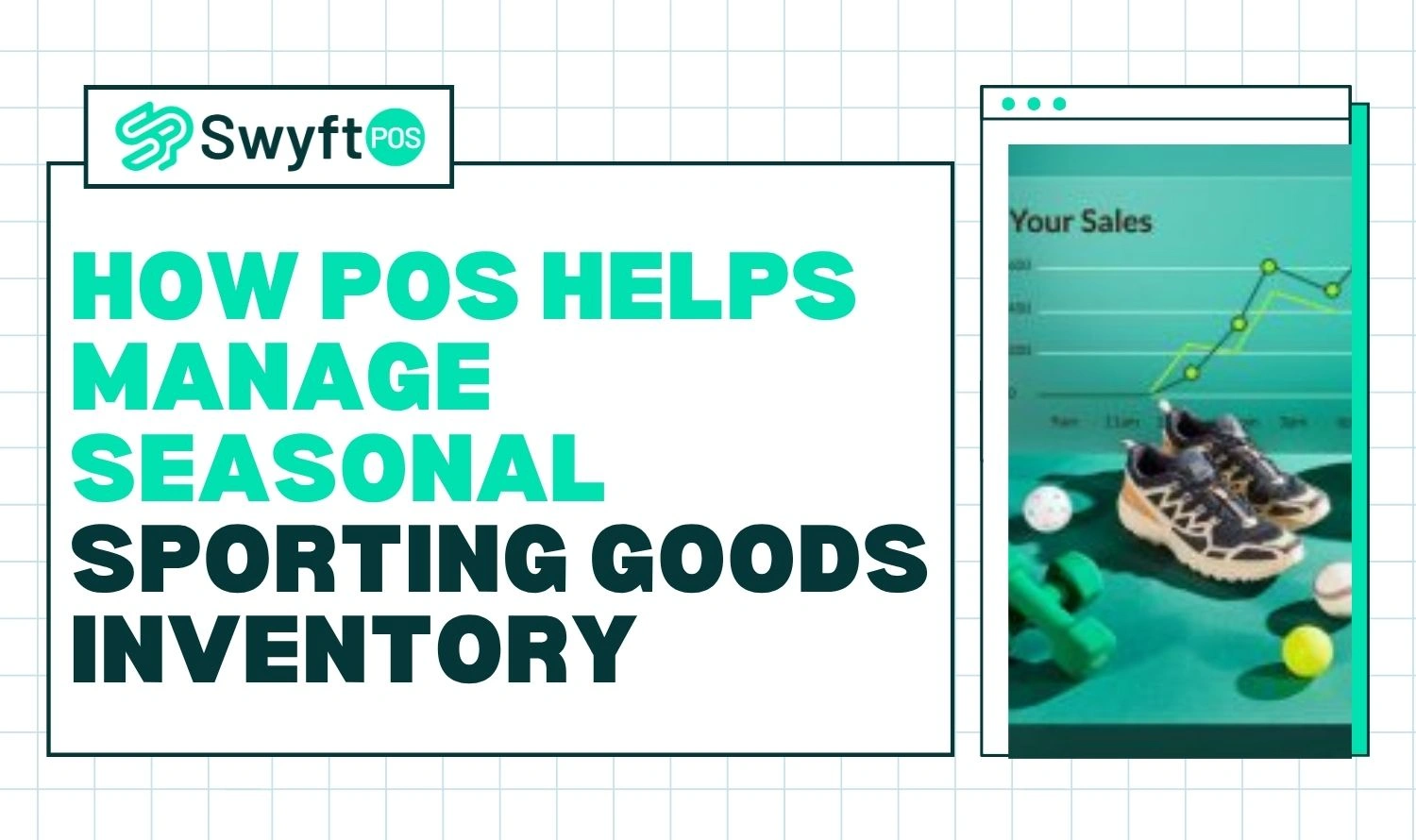Walk into a sporting goods store in December, and you’ll see snow gear piled high. Walk into the same store in July, and you’ll find beachwear and camping gear instead. That constant rotation (between skis and surfboards, helmets and kayaks) is what makes this business both exciting and challenging.
Let’s explore how a Point-of-Sale (POS) system quietly becomes your smartest teammate when it comes to managing all that seasonal inventory.
The Seasonal Reality in Sporting Goods Retail
Every sport has a season, and every season brings its own inventory headache. Understanding the types of POS systems can help retailers handle these shifts smoothly and stay stocked when demand peaks.
- Winter: Ski jackets, gloves, hockey sticks.
- Summer: Tents, bicycles, swimwear.
- Spring/Fall: Running gear, outdoor training shoes, backpacks.
If you don’t have the right products at the right time, you lose more than sales — you lose trust.

A modern sporting goods point-of-sale system helps prevent that by combining data, timing, and insight into one clear view.
Understanding Why Manual Tracking Fails
You can’t manage fast-moving, seasonal inventory with spreadsheets alone.
Manual systems:
- Miss real-time sales trends.
- Cause stockouts during rush periods.
- Make reordering guesswork, not strategy.
A POS system changes that. It tells you what’s happening right now — so you can act before it becomes a problem. That’s the beauty of how POS helps retailers make timely, data-driven decisions.
15 Ways How POS Helps Manage Seasonal Sporting Goods Inventory
Here are a few ways how POS helps:
1. Real-time Stock Monitoring
Imagine being able to see your stock levels like a live video feed. That’s what real-time inventory tracking does.
If snowboards are selling faster than expected, your POS alerts you instantly. If swimwear sales drop early in the season, you know it before your warehouse overflows.
Why it helps:
- Keeps shelves balanced year-round.
- Prevents dead stock buildup.
- Gives managers data to make confident calls.
2. Forecasting with Historical Sales Data
Every season leaves behind a story — and your POS system remembers it.
By analyzing last year’s sales data, you can see:
- Which months had the highest turnover
- Which brands moved slowest
- When customer interest started shifting
That information becomes your best friend when planning for next year. Instead of guessing, you’re predicting.
You know that the “pre-ski” season starts in mid-October, not November. You know when to run early promotions.
3. Understanding Customer Buying Cycles
Customers don’t buy gear randomly — they follow predictable patterns.
Your POS collects valuable information:
- When customers start purchasing seasonal products
- Which regions buy earlier or later
- Who prefers clearance deals vs. new launches

By reading these patterns, you can adjust ordering cycles and pricing strategies. You’re not reacting to seasons anymore — you’re leading them.
4. Simplifying Supplier Coordination
Most sporting goods retailers rely on multiple suppliers.
It’s easy to lose track — especially during busy transitions between seasons.
With a POS that integrates supplier data, you can:
- Track supplier performance over time.
- Reorder directly through the same dashboard.
- Spot delays before they affect your sales floor.
Your sporting goods point-of-sale system becomes the bridge between your suppliers and your shelves.
5. Automating Reorders During Peak Season
When your best-selling product suddenly disappears from shelves, it’s usually because someone forgot to reorder on time.
POS automation solves that problem. You can set low-stock alerts—or even let the system reorder automatically once a threshold is reached.
Example:
“When hockey sticks drop below 12 units, send an order to Supplier B.”
You never run out of gear again, even when the season’s rush hits hard.
6. Managing Multi-location Stores Easily
If you run multiple branches, you know how uneven demand can get. One store might be clearing out winter jackets while another still needs restocks.
With cloud-based POS, you can:
- Track stock across all branches.
- Transfer products where needed.
- Avoid unnecessary new orders.
That’s how POS helps you maintain balance between stores, no matter the season.
7. Avoiding Overstock with Smarter Insights
Overstock kills profit faster than you think. Every unsold snowboard takes up shelf space and cash flow.
Your POS system tracks slow-moving products and alerts you early. That gives you time to discount them strategically — before they become dead stock.
It’s not about selling everything. It’s about selling smartly.
8. Merging Online and In-store Sales Data
Today’s customers move between your website and your store like it’s one place.
A POS that syncs online and offline inventory ensures:
- You don’t oversell products listed on your website.
- Online returns update the store stock automatically.
- Discounts and offers work across both platforms.
For seasonal items, like back-to-school gear or summer clearance, this keeps everything perfectly aligned.
9. Training Staff Faster with Simple POS Tools
Seasonal hiring is common in sports retail. You bring in new staff for busy months, but training can eat up precious time.
Modern POS systems are user-friendly and intuitive. Your employees can learn:
- How to process returns, discounts, and exchanges.
- How to check stock between stores.
- How to assist customers with real-time product info.
Faster onboarding means smoother customer experiences, especially when the store gets busy.
10. Using POS Analytics to Set Pricing
Pricing can’t stay fixed all year. You need dynamic control — especially during high-demand and clearance periods.
Your POS data helps you:
- Identify bestsellers that can handle premium pricing.
- Spot items ready for markdowns.
- Time promotions to match buying cycles.
Example:
“Running gear peaks in March — launch your sale in mid-February.”
That’s smart timing made simple by data.
11. Tracking Returns and Repairs Smoothly
Sports gear isn’t cheap, and returns are common—especially for size issues or seasonal defects.
A POS system records every return, reason, and replacement. Over time, you can see:
- Which products have recurring quality issues
- Which brands cause the most returns
- How to improve future orders
Clean return data leads to cleaner buying decisions next season.
12. Preparing Staff for Seasonal Rushes
A POS helps you predict traffic spikes.
If your reports show a sales jump every April, you can schedule extra staff before the rush starts.
You can even analyze:
- What time of day customers shop most
- Which checkout counters get overloaded
This planning keeps lines short and morale high — 2 things every busy season needs.
13. Streamlining Promotions and Discounts
Seasonal promotions bring crowds, but chaos too. A POS lets you pre-set discounts, loyalty rewards, and bundles ahead of time.
When checkout happens, the system applies promotions automatically — no manual overrides or confusion.
And after the sale, you’ll see exactly which campaigns worked best. That means better planning for next year’s sales calendar.
14. Integrating POS with Accounting Tools
Between different seasons, your finances change drastically. A POS with accounting integration keeps your books clean while you sell.
It syncs:
- Sales and revenue
- Taxes and vendor costs
- Seasonal reports for profit tracking
You always know which season was profitable — and which wasn’t. That’s powerful for long-term growth.
15. Preparing for Next Season with Confidence
Every sale you make today prepares you for tomorrow.
When the season ends, your POS hands you the story of what worked and what didn’t.
You’ll know:
- Which categories to scale up next year
- Which suppliers delivered best
- Which products should be discontinued
That insight means every new season starts smoother than the last.
Why POS Systems are Now a Must-have
A POS isn’t just a register anymore — it’s your data assistant, your stock analyst, your operations manager.
For a sporting goods retailer, that means:
- No more frantic end-of-season clearances.
- No more “oops, we’re out of size M.”
- No more guessing games with suppliers.
You gain control, not chaos.
How Smaller Sports Stores Benefit Too
You don’t need a nationwide chain to see results. Even small, independent stores benefit from:
- Real-time product visibility
- Simple reordering
- Customer tracking for loyalty programs
A smaller team with smart tools can outperform a large one with guesswork.
The Human Side of POS
Behind every system is a simple goal — making life easier.
A good POS helps you focus on what matters most: helping customers find the gear they love.
Whether it’s a kid buying their first soccer shoes or a mountain climber upgrading their rope, every sale becomes smoother when your tools work quietly in the background.
Final Thoughts
Managing seasonal sporting goods inventory used to mean stress, spreadsheets, and educated guesses.
Now, it means data, insight, and preparation.
A well-chosen POS system gives you the rhythm your store needs — moving from ski season to surf season without missing a beat.
The difference shows in your shelves, your customers, and your profits.
Because while seasons change, smart systems don’t — they simply adapt with you.
Don’t let seasonal chaos slow you down. Swyft POS helps you track, forecast, and automate stock management effortlessly. Contact our team now to see how retailers simplify every season with us.
FAQs
1. How does Swyft POS help manage seasonal sporting goods inventory?
Swyft POS tracks inventory in real-time, predicts demand using sales history, and automates reordering, so you never run out of popular seasonal items or overstock slow-moving gear.
2. Can Swyft POS handle multiple store locations during seasonal peaks?
Yes, Swyft POS syncs inventory data across all branches, allowing you to balance stock between stores, transfer products easily, and maintain visibility during busy sporting seasons.
3. Does Swyft POS integrate with online sporting goods stores?
Absolutely. Swyft POS integrates with Shopify, WooCommerce, and other platforms, keeping your online and in-store inventory synchronized for smooth order management and seasonal sales tracking.
4. Can Swyft POS generate reports for seasonal performance?
Yes. Swyft POS provides detailed, customizable reports that highlight top-performing products, supplier efficiency, and sales trends — helping you make smarter buying decisions for future seasons.
5. How does Swyft POS support small sporting goods retailers?
Swyft POS is built for flexibility. It offers affordable plans, easy setup, and automation tools that help smaller retailers manage inventory like enterprise-level stores — without extra overhead.





